Sendero Libélulas
Suitable for all the family.
The Dragonflies of the Guadalmina path is a pleasant walk suitable for anyone who is reasonably fit and does not have any mobility issues.
The Dragonflies of the Guadalmina path is a pleasant walk suitable for anyone who is reasonably fit and does not have any mobility issues. There is a lot more to dragonflies than meets the eye, and this route offers the opportunity to enter the world of these fascinating insects. As well as the river, the scenery and the typical Mediterranean flora, you will walk past some vestiges of times gone by like the lime kiln. In the past, you would have walked among mills, crops and livestock enclosures that are now left to the imagination. Throughout the route, you walk close to the banks of the Guadalmina, eventually skirting the weir to reach the road to Benahavís where the route ends.
THE FURNACE CALERA
The furnace was constructed by means of excavating in the hillside of the mountain a cylindrical shaped pit about 2-3 metres in diameter and 3-4 metres deep. It is usually internally covered with a wall made of granitic stones, the layer closest to the surface calle “the parapet” and it is formed by larger granitic stones. In the lowest part of the pit the cylinder reduces its diameter in such a way that inside the pit, around it, a small stone bech or “poyal” which will be used as a base to rest the stones to be baked. This small stone bench is 70 cm high and forms the walls ot the furnace caldron or “calderuela” where the firewood will be burn. A ramp is excavated by one of the laterals of the pit from the surface to the base, forming “the mouth” of the furnace. This zone is called “the server” and it is where the lime burner places loading the furnace with firewood.
Benahavís
THE QUICKLIME
The “quicklime” is made by the calcination of the limestone to 1000 ºC for a period of 20 to 30 hours. The quicklime is very caustic and it has a great affinity with water and when they come into contact it transforms into calcium hydroxide or “slaked lime” emitting a high hot quantity.
The use of the quicklime for the manufacture of mortar has been essential to build solid constructions. Mortar is obtained by mixing slaked lime with sand and water. When the mortar is formed, the quicklime hardens, recovering the CO2 in the atmosphere to transform again into calcium carbonate, recovering its original hardness, whiteness and impermeability.
The slaked lime dissolved into water is the “milk of lime” being traditionally used to whitewash the walls of the houses. This film has a marked white colour and it is waterproct that is why it is widely used in our towns.
Did you know that
The milk of lime is also used to disinfect the trees, to prevent the putrefaction of the stagnant water…
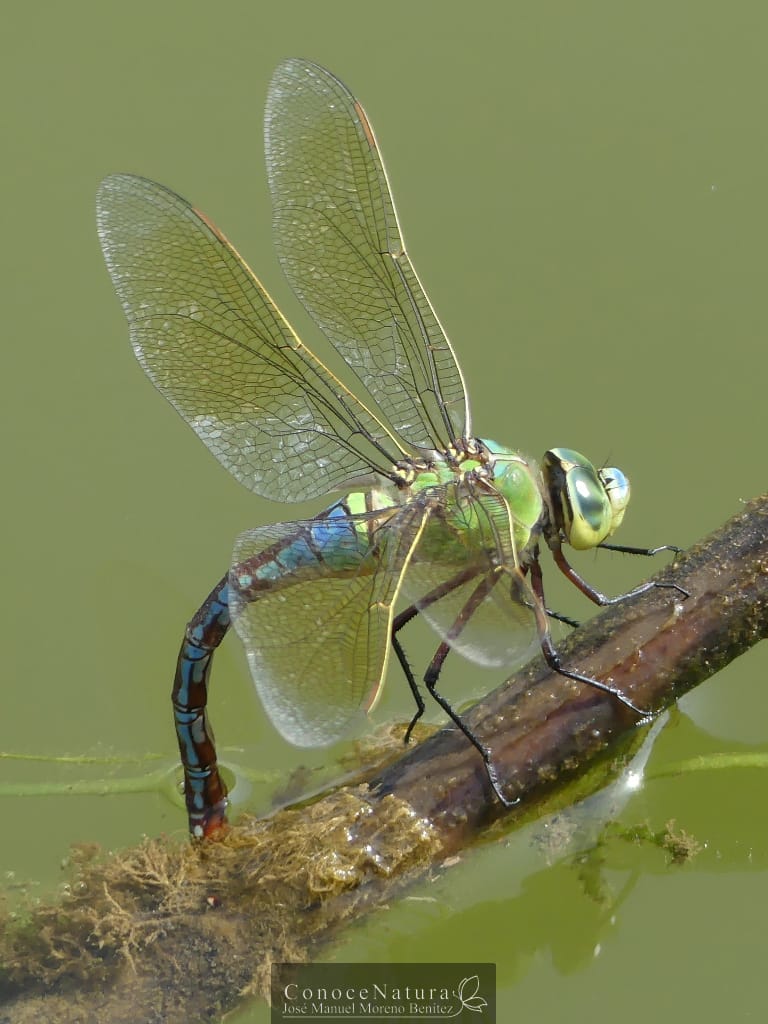
Introduction to Benahavis' Dragonflies
What is a dragonfly?
Dragonflies are insects with two main phases. The larvae develop in the water (1), while the adult develops outside the water (2). In both periods, they feed on other invertebrates, especially flies and mosquitoes. They are divided into two groups: damselflies and true dragonflies. The former are more flighty and fold their wings back when they perch (3), while the latter have a more powerful flight and when perching leave their wings open, in the form of a cross (4).
The reproduction
The larval phase takes place mainly in fresh, stagnant or flowing water bodies. At the moment of coupling they form a heart (5). This is because the male grabs the female by the head or neck so that she can couple her genital apparatus with the male’s seminal deposit. They lay their eggs alone or paired. They do so in flight over the water (6) or inns over aquatic vegetation (7) and some species by introducing them to riverside plants.
Dragonflies of Benahavis
Benahavís is home to 32 of Malaga’s 54 known species, making it one of the municipalities with the greatest diversity of dragonflies in the province. The diversity and quality of its aquatic environments are the reason for this high variety. The Guadalmina (8), Guadaiza (9) and Guadalmansa rivers, with their respective tributaries and reservoirs (10), are ideal places for the observation of dragonflies. On the tour we propose you can see up to 28 species throughout the year.
The Kingdom of Shadows
The Riverside Forest
In front of you has a dense willow that provides dense shade to a good part of the river channel. The preferred environment of a series of dragonflies and caballitos that feed on the flies and mosquitoes that take refuge in the riparian vegetation.
Calopteryx haemorrhoidalis. Unmistakable both the male (1) and the female (2). The first for its black color and the second for the dark spots on the apex of the wings.
Chalcolestes viridis (3). Its green color makes it go unnoticed but can be seen flying and perching in the brambles.
Platycnemis latipes (4). It stands out in the landscape due to its clear coloring and active behavior. It is common to see it tens of meters of the water, raising the flight in our path.
Boyeria irene (5). It does not go unnoticed due to its large size, faltering flight and habit of looking for food on the shore, among the vegetation, slopes and bare roots.
Cordulegaster boltonii (6). One of the largest and most striking dragonflies, with turquoise eyes and brindle design and coloring.
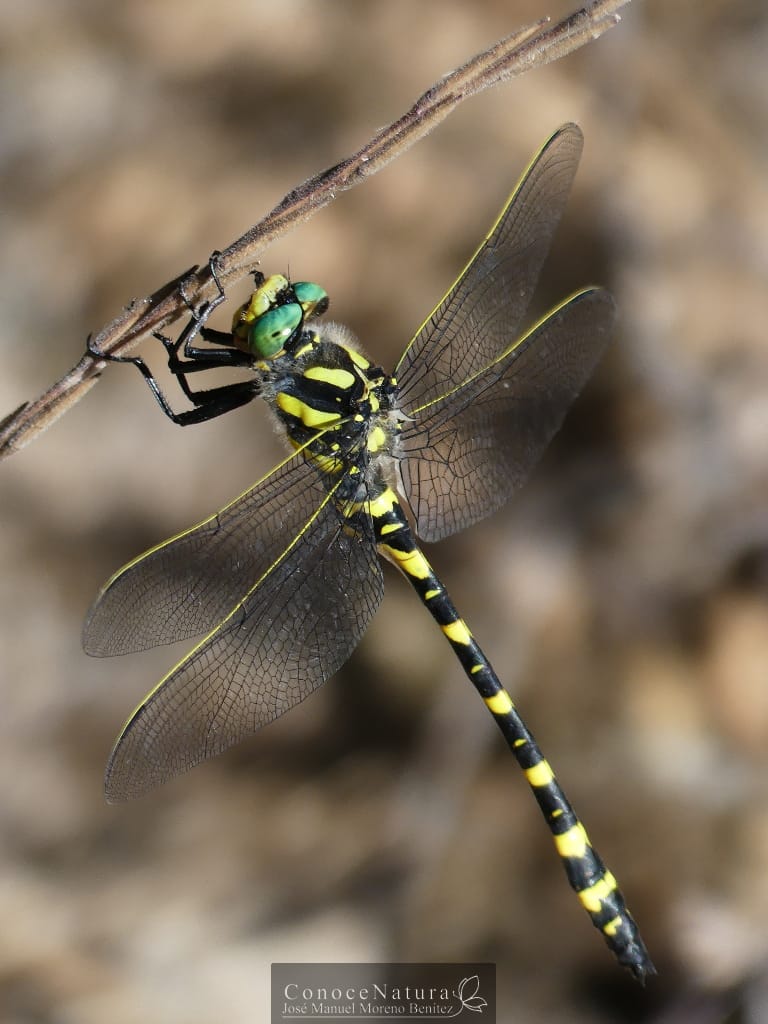
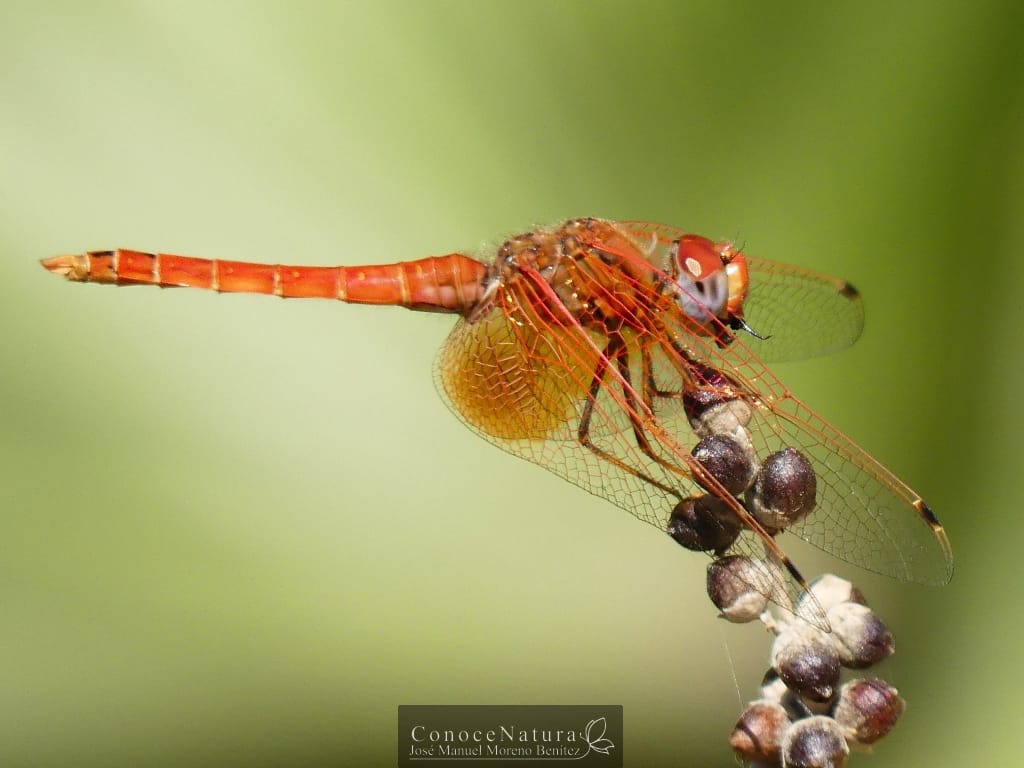
From Africa to Europa
The colonization of a continent
In this section of the trail you can observe 3 dragonflies coming from the African continent that have gradually colonized Europe. There are scientists who attribute this colonization to the effects of global warming.
All of them occupy open and warm bodies of water, such as pools in rivers and streams, reservoirs, artificial ponds, pylons and troughs, among others.
Crotothemis erythraea (1). The male is an intense red color and differs from the other two species in its somewhat larger and more robust appearance and by having the abdomen more flattened.
Trithemis annulata (2). The main characteristic that differentiates the male from the other two species is its purple red color. Its colonization in the Iberian Peninsula began in the late 1970s.
Trithemis kirbyi (3). The male is the most striking of the three, because of its intense red color and the large orange spots at the base of each wing, smaller in the other two species. It was first detected on the European continent almost at the same time in Italy and Spain, where it was first found in the Malaga municipality of Casares.
Emperaror dragonfly
Emperor dragonfly, Anax imperator
You are facing one of the largest dragonflies on the European continent.
With its almost 9 cm long, its impresive flight and its striking colors, it does not go unnoticed wherever it lives.
The male constantly patrols the mass of water, defending his territory against other dragonflies, waiting for a female to go to the place chosen to breed. These are usually tamed or stagnant waters, such as pools in rivers and streams, reservoirs and artificial ponds. Always in places with riverside vegetation, such as bulrushes and reeds. After copulation, the female separates from her partner and looks for a secluded and quiet place, with floating plant debris where she can deposit her eggs.
It feeds on all types of invertebrates, mainly flies and mosquitoes that it hunts on the fly. Sometimes it can devour other species of dragonflies.
The best months to observe it are from June to September.
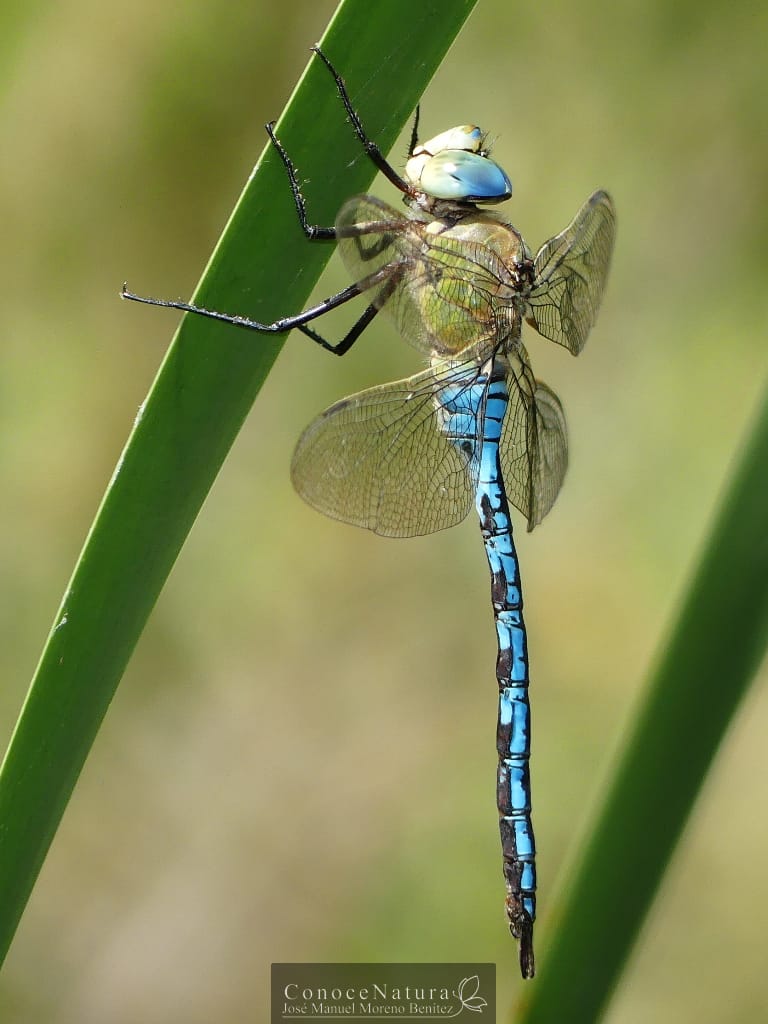
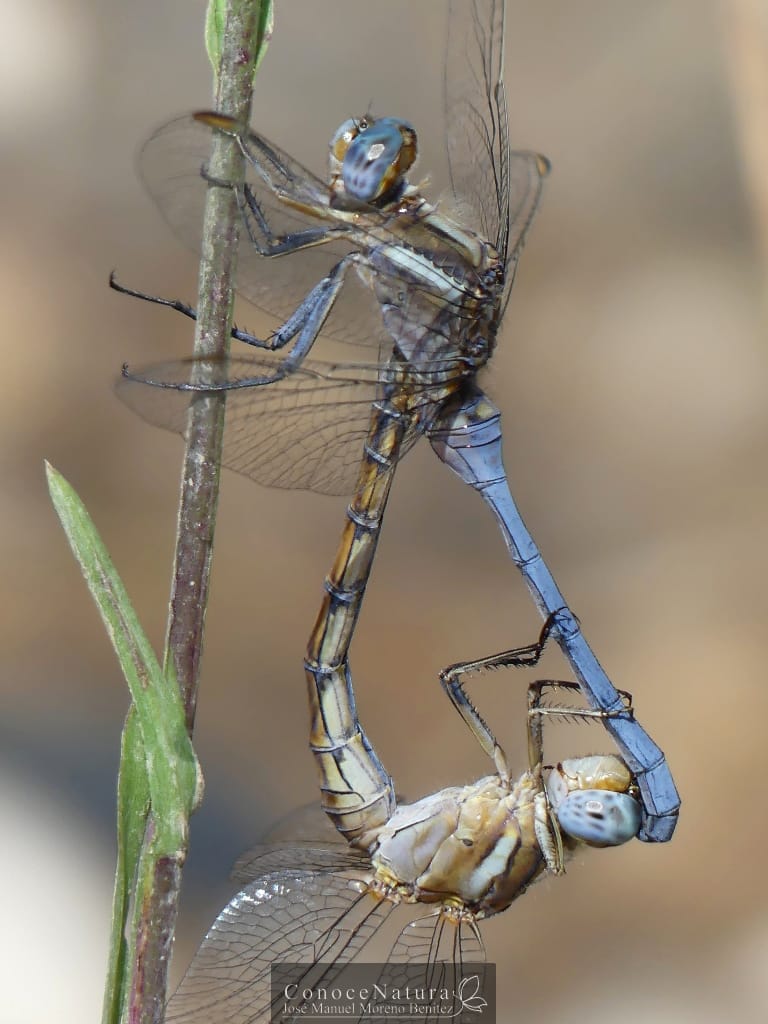
The Oasis of the Dragonflies
Guadalmina Reservoir
Go completely throught the Guadalmina reservoir and you will discover with your own eyes a real oasis for dragonflies.
On its shores and water inside, up to 22 species have been dated. A high diversity thanks to it little steep banks and its water level, stable both seasonally and interannually, which allows the settlement of riparian vegetation, essential for most dragonflies.
You can observe many of the species mentioned in previous panels, and others that are typical of reservoirs and stagnant waters, such as Ischnura graellsii (1), Erythromma lindenii (2), Anax parthenope (3), Orthetrum chrysostigma (4), Orthetrum trinacria (5) and Brachythemis impartita (6).
Untamed Guadalmina
The Crown Jewel
The Guadalmina River, upstream from its reservoir, shows its wildest and most natural side. During spring and summer, its ravines, wide rocky channels and crystal-clear water pools harbor some of the most valuable dragonflies in Benahavís, real jewels that must be preserved.
You will find species of all colors and designs, among which stands out the emblematic Oxygastra curtisii (1), with emerald eyes and metallic colors all over its body, threatened and protected by law. Although they have not been discovered yet, it is suspected that two other protected species can be found: Gomphus graslinii and Macromia splendens, the most threatened dragonfly in Spain.
Patrolling constantly up and down the river, or tens of meters above its head at sunset, it will not be difficult to spot Zygonyx torridus (2).
In the vegetation of the shore, the orange color of the small Platycnemis acutipennis (3) and the intense blue of Orthetrum coerulescens (4) will call your attention.
The bed of boulders is the home of Onychogomphus forcipatus (5), very striking for its turquoise eyes, graceful body design and hooks in the final part of the body.
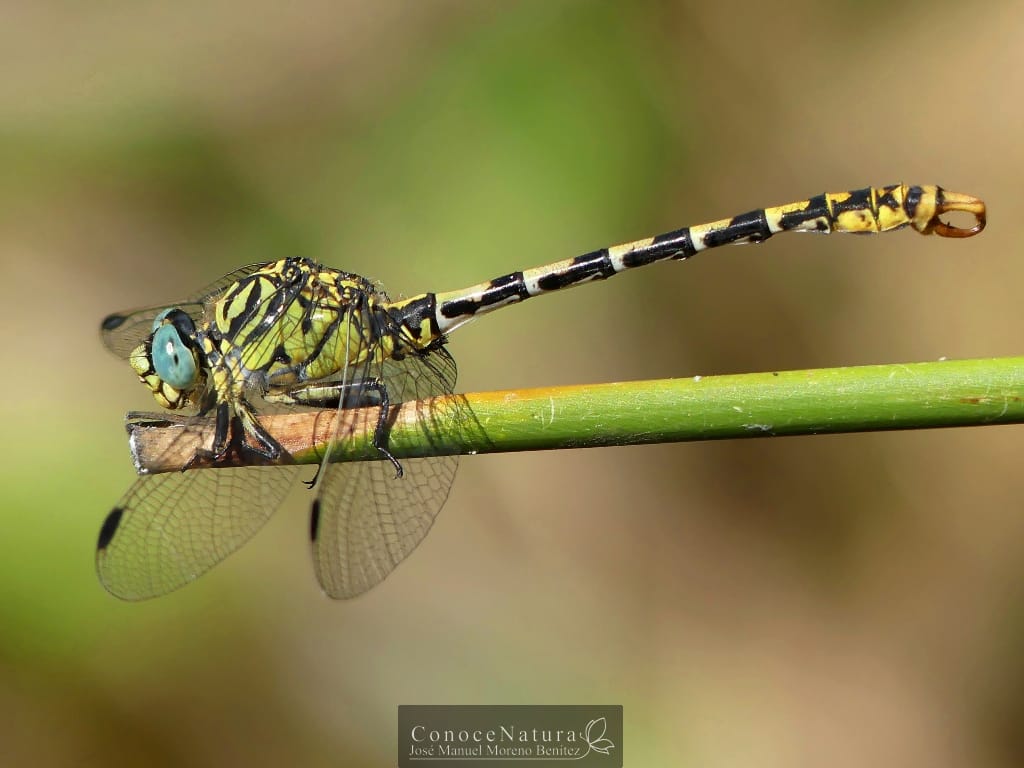
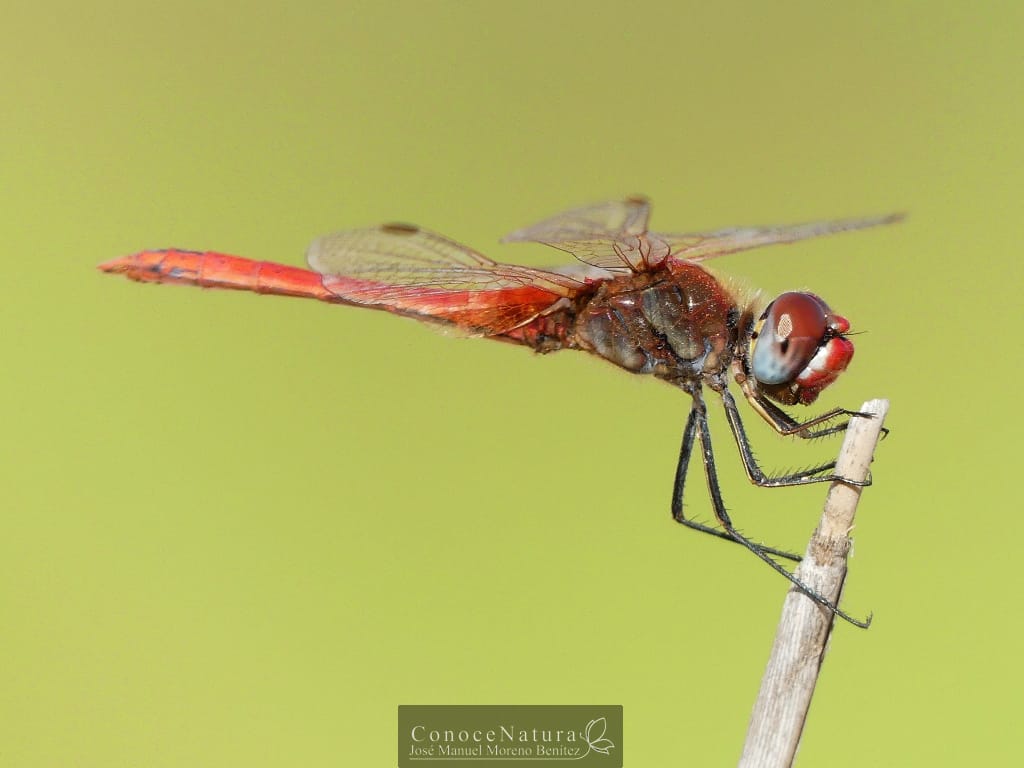
"Dry land" dragonflies
Dispersion and migration
Dragonflies can move away from the water to mature sexually, feed, or find new breeding sites. To do this, they disperse or migrate from a few meters to kilometers. Some of the species that are often seen far from water are:
Sympecma fusca (1). It is the only species that spends the winter as an adult, and can be seen miles away from water, sheltered in forest areas.
Anax ephippiger (2). Powerful migrant that each year colonizes a large part of the European continent from its breeding grounds in Africa and southern Europe.
Aeshna mixed (3). After the emergency, they disperse and take refuge for months in forest and mountain environments, far from water. When they reach sexual maturity, they return to the water bodies to reproduce.
Sympetrum fonscolombii (4). Migratory species that in favorable years can suddenly appear by the thousands in specific places, sometimes far from water.



